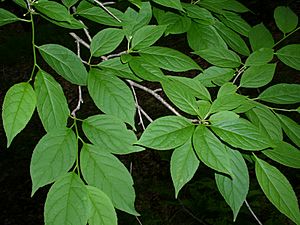Mountain winterberry facts for kids
Quick facts for kids Mountain winterberry |
|
|---|---|
 |
|
| Conservation status | |
| Scientific classification | |
| Genus: |
Ilex
|
| Species: |
montana
|
 |
|
| Natural range | |
Ilex montana, often called the mountain winterberry, is a type of holly plant. You might also hear it called 'mountain holly,' but that name usually refers to a different plant. This plant grows naturally in the Eastern United States. You can find it along the Appalachian Mountains, from Massachusetts in the north all the way down to Alabama and Georgia. It is not considered an endangered species.
What Does the Mountain Winterberry Look Like?
The mountain winterberry is a deciduous shrub or a small tree. This means it loses its leaves in the fall, just like many trees in your backyard. It can grow quite tall, reaching about 30 to 40 feet (9 to 12 meters) high.
Its leaves are light green and shaped like an oval or oblong. They are usually 3 to 9 centimeters (about 1 to 3.5 inches) long and 2 to 5 centimeters (about 1 to 2 inches) wide. Unlike many hollies you might know, these leaves do not have sharp spines. They have a slightly jagged edge and come to a point at the tip. In late autumn, the leaves turn a bright yellow color before falling off.
Flowers and Fruit
The mountain winterberry has small, white flowers that are about 4 to 5 millimeters (less than half an inch) across. These flowers have four petals and appear in late spring. At this time, the leaves are already more than half grown.
After the flowers, the plant produces bright red, round berries. These berries are about 8 to 10 millimeters (about a third of an inch) wide. Each berry contains four seeds.
How Is It Classified?
Some plant experts consider Ilex montana to be a type of another related plant, Ilex ambigua, which is also known as Sand Holly. They sometimes call it I. ambigua var. monticola. People sometimes confuse these two plants, especially in the southeastern coastal areas of the U.S.
The second part of its scientific name, montana, is a Latin word. It means "of the mountains" or "coming from mountains." This name makes sense because the plant grows in the Appalachian Mountains.


